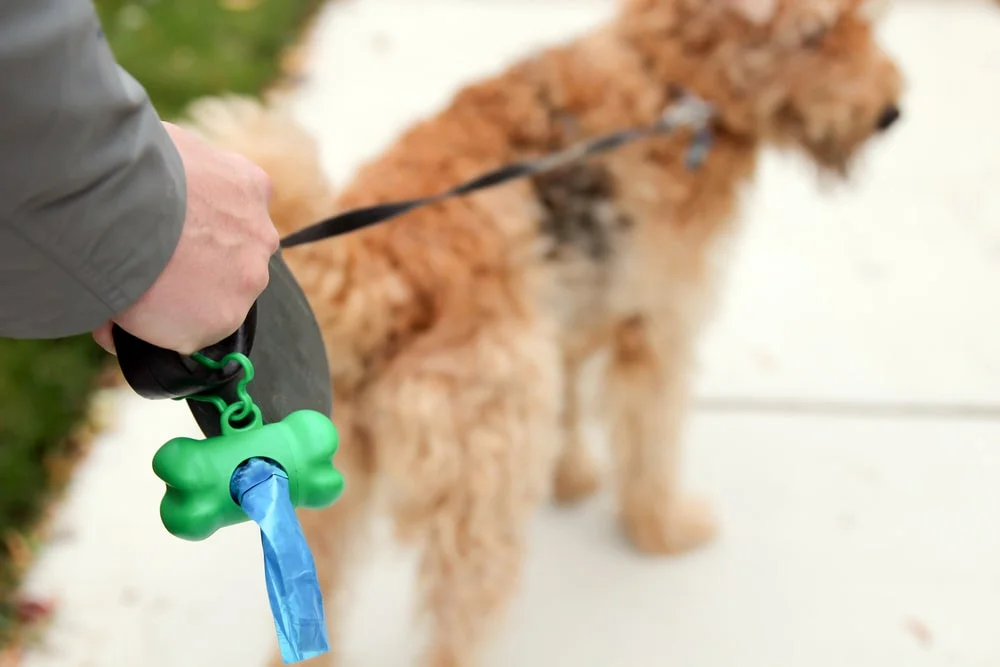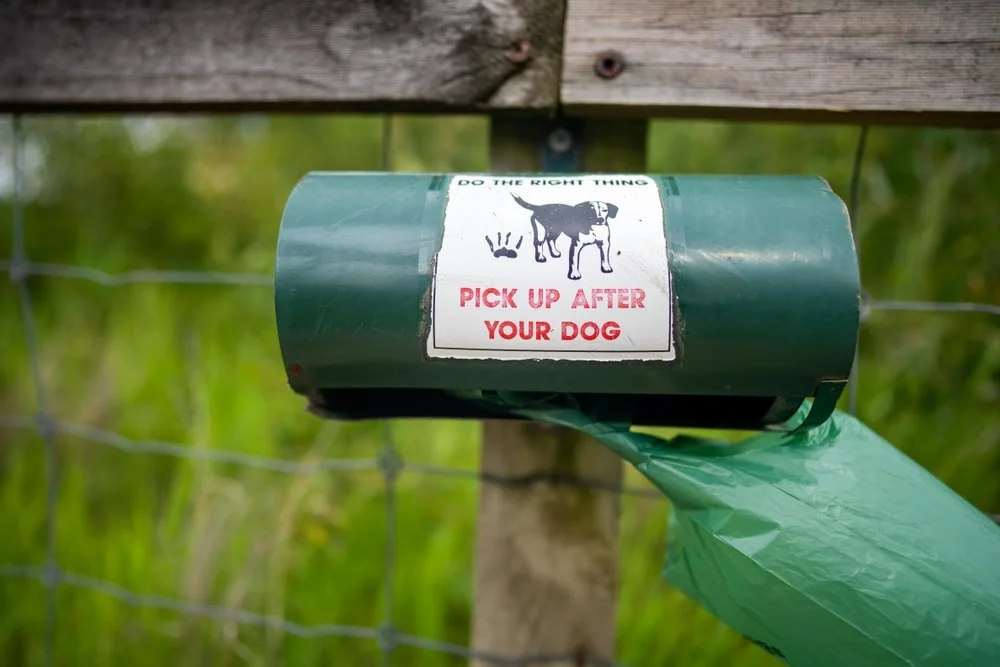PET HEALTH
One of the least exciting parts of being a dog parent can be cleaning up your dog’s poop, but this stinky chore can help you keep an eye on your dog’s health. Let’s discuss what to look for when it comes to dog poop, when to call the vet if you notice something isn’t normal, and answer a few common dog poop questions.
What Should Dog Poop Look Like?
The way dog poop looks can help pet parents figure out what’s going on inside their dog’s body. A healthy dog’s poop should be:¹
- Brown
- Log or sausage shaped
- Moist
- Easy to pick up
- Playdough consistency
Keep in mind that it can be normal for your dog’s poop to have undigested grass, food, or other items in it. Taking a look at their poop can help you spot anything your pup may have eaten, whether good or bad.
Pay attention to the amount of poop they produce because this can tell you how much they’ve been eating. You can adjust their diet accordingly once you know what’s normal for your dog’s weight, size, and lifestyle.
Dog Stool Consistency
In a perfect world, our dogs wouldn’t get sick, but their poop can tell us a different story. One of the keys to piecing together what’s going on with your dog is the consistency of their stool. If the dog stool consistency is dry, pebble-like, mushy, or watery then it could be a sign of something wrong.
Dry dog poop
Dry dog poop often has visible cracks on the surface and comes out in smaller, individual pellets. You may notice that your dog’s struggling to pass these pebble-like stools. When you pick up dry poop, it may leave a residue on the ground.
If this is happening, it may be a sign that your dog is constipated. Constipation happens when stool doesn’t pass through the large intestines like it should. This can happen for a number of reasons like dehydration, electrolyte imbalances, or poor exercise habits.
A great way to correct constipation is to increase the amount of water your pup is drinking and make sure they exercise regularly. However, it may be a good idea to speak to your veterinarian if the constipation lasts for more than 48 hours to see if your dog needs medical assistance.
Mushy dog poop or watery dog doop
Mushy or watery dog poop can look like a blob or a puddle that leaves a distinct residue behind when it’s picked up. This can be an indicator that your dog may have a bout of diarrhea.
Diarrhea can be caused by a host of issues — including changes in your dog’s diet and possibly stress — so most vets recommend monitoring your pet for at least 24 hours to see if your dog’s stool goes back to normal. Your vet may also recommend your dog fast and only drink water during that time, then slowly reintroduce their regular food to them.
If you don’t see any improvement, contact your vet as they may want you to bring your pup in for diagnostic testing. Your vet can rule out major causes of diarrhea like parasites. If you have a MetLife Pet insurance policy, you may be able to use the 24/7 vet chat feature to get answers in real time.2
Dog Stool Color
Now that you know what dog poop should and shouldn’t look like in terms of shape and consistency, let’s talk about color. The color of your dog’s poop can tell you a lot about their health. American Kennel Club’s “color wheel of dog poop” tells pet parents that a vet should be consulted if their dog’s poop is any other color but brown.¹
Some colors like red, orange, or green could be from eating certain foods like beets, carrots, or grass, while others can be signs of dietary issues or major health concerns. Here’s what certain poop colors could be trying to tell you about your dog’s well-being.
Green dog poop
Green poop can be a sign that your dog ate too much grass. Dogs can safely munch on grass, but this snack can be difficult to digest. Teaching your dog “leave it” or “come” can help train them to leave the grassy snack alone.
However, green poop over several days may indicate gallbladder issues.¹ It’s recommended that you chat with your vet for further guidance on what to do if you notice green poop. They may ask you to watch your pet’s bowel movements for 2 days or they may ask you to come in immediately. Your vet’s advice will depend on your dog’s age, breed, existing health conditions, and their lifestyle.
Orange dog poop
Orange poop could be an indication that your dog may have biliary disease or liver disease.1 Biliary disease refers to a bunch of different illnesses that affect your dog’s gallbladder — a major organ that helps them break down waste.3
If your pet hasn’t consumed carrots or other orange-colored foods, this could be a health issue that shouldn’t be ignored. It’s highly advised to call your vet if you notice orange stools so your dog’s liver and gallbladder functions can be examined.
White dog poop
If you see white, sesame seed-like specks in your dog's poop it may be a sign that they have tapeworms.¹
Tapeworms are a common infection that passes through the gastrointestinal tract during the final stages of the parasite’s life cycle. Luckily, this is treatable with a prescription from your vet. You may want to give them a call to discuss the next steps for treating your dog’s infection.
Black dog poop
Black, tarry poop could mean bleeding somewhere in your dog’s upper gastrointestinal tract.1 Internal bleeding typically needs to be treated immediately, so veer on the side of caution if your pup has black stools. It’s recommended to call your vet so you can start potential treatment early.
Gray dog poop
Similar to orange colored poops, gray and greasy poops may be a sign of biliary disease. Gray poops may also be a sign of pancreatic disorders.1
You may want to monitor your dog over a span of 48 hours for other signs of illness while you get in contact with your vet. They may ask you to come in for an exam and collect fresh stool samples.
Blood in dog poop
If you find blood in your dog’s stool, it may not be cause for panic because blood doesn’t always mean your pup is sick. Check your dog’s anus and anal glands to see if there are cuts, inflammation, or pus. If you can’t see anything with the naked eye, pay attention to other behaviors that may indicate that something is wrong with their anal glands like:
- Licking their butt
- Scooting or dragging their butt
- Discomfort while sitting
- Straining while they’re pooping
On the other hand, depending on the color of the blood, it could mean intestinal parasites, trauma, blockages in the gastrointestinal tract, or more serious health conditions. Speak with your vet about running diagnostic tests to figure out what could be going on.
Mucus in dog poop
Mucus in dog poop can be an indicator that your dog’s colon is inflamed. However, the mucus could be coming from a change in diet, so it may be a good idea to speak with your vet. They can perform tests to rule out colon inflammation and other gastrointestinal disorders.
When to Call Your Vet About Your Dog’s Poop
Chat with your vet if you notice any major changes in your dog’s poop. They can help guide you towards specific solutions, like increasing your dog’s water intake if they are constipated or switching to different foods. Vets can also recommend what to give your dog at home if they have an upset stomach.
A good rule of thumb can be to monitor your dog for at least 2 days to look for any changes in their bowel movements. If the problem persists, you might want to schedule a visit with your vet for a thorough exam.
Dog Poop FAQs
Pet parents have many pressing questions about their dog’s poop. After all, our dogs can’t tell us when something’s wrong. We’ve got you covered with some common questions and answers about dog poop.
What do worms look like in dog poop?
You may find different types of worms in dog poop. Tapeworms often look like white grains of rice or sesame seeds. These flecks can get stuck to your dogs tail, legs, and butt. Other types of worms — like whipworms, roundworms, or hookworms — sometimes exit a dog’s body whole or their eggs can be found in stool. It’s best to consult with your vet if you spot these sorts of worms because they can make your dog very sick if left untreated.
My dog ate poop. What should I do?
Dogs eat poop for many different reasons but the behavior is typically considered normal, especially in young dogs and puppies. However, adult dogs shouldn’t eat their poop or other animal feces. If they do, your dog may be at risk of becoming very sick. It’s important to note that your dog may also be inclined to eat poop if they’re sick with a parasitic infection or a condition like diabetes.
It’s best to speak to your vet if your dog is making feces a part of their snacking habits. Your vet will likely test your pet for vitamin deficiencies or other health conditions and offer solutions to help curb the behavior.
How to get dog poop out of carpet
Accidents happen, no matter how old our beloved dogs get. If your dog poops on the carpet, here’s what you can do to clean it up:4
- Pick up the larger pieces of poop immediately.
- Blot the area with a wet paper towel or baby wipes.
- Spray the stain with a homemade solution or store-bought carpet cleaner.
- Let the solution sit for 3 – 5 minutes.
- Gently blot the area until the mess is gone.
- Repeat if necessary.
Cleaning stains out of the carpet may take a bit of elbow grease. If you can’t get the stains out, you may have to rent a carpet cleaner or hire a professional to get it perfectly clean.
MetLife Pet Insurance Can Help With Stinky Vet Bills
Poop can tell us a lot about our dog’s health. From its shape and color, poop can be the first sign of illnesses and disorders that may lead to costly vet bills.
You may want to consider investing in a MetLife Pet Insurance policy for your dog so you can relieve some of the stress from surprise bills. Our policies can cover anywhere between 80% – 100% of your vet bill.5 Get a free quote today to find a dog insurance policy that works for you and your family.


